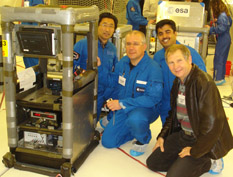Press Release
That's Hot: Engineers to Test Boiling at Zero-Gravity
Experiment Launches with Shuttle Discovery to International Space Station
FOR IMMEDIATE RELEASE February 24, 2011
CONTACT:
Melissa Corley
301 405 6501
mcorley@umd.edu

Team members on the European Space Agency A300 aircraft in April 2010. From left to right: Jungho Kim, Paolo DiMarco (professor, University of Pisa), Rishi Raj (graduate student), and Serguei Dessiatoun (research professor, U-Md.). (For the hi-res version, click here.)
COLLEGE PARK, Md.--Here on Earth, the process of boiling is used for tasks ranging from cooking and heating to power generation. In space exploration, boiling may also be used for power generation and other applications, but because boiling works differently in a zero-gravity environment, it is difficult to design hardware that will not overheat or cause other problems.
Professor Jungho Kim of the A. James Clark School's Department of Mechanical Engineering at the University of Maryland, College Park, is working with John McQuillen, project scientist at NASA's Glenn Research Center in Ohio, to study how boiling is altered in zero-gravity. Their experiment, the Microheater Array Boiling Experiment (MABE), will launch on the Shuttle Discovery on February 24 and be placed aboard the International Space Station for operation in the following few months. The experiment, which has already been tested on NASA's "Vomit Comet" and the European Space Agency's Parabolic Flight Campaign in France, will be installed in the Microgravity Science Glovebox once aboard the ISS.
The results of the experiment could help engineers design space hardware that utilizes boiling for multiple applications.
Video #1 (above): This video shows how the boiling experiment was conducted on the "Vomit Comet." |
"In space, boiling may be required to generate vapor to power turbines in some advanced concepts for power generation, for temperature control aboard spacecraft, and for water purification," says Kim.
When a liquid is boiled on Earth, vapor, which is less dense than liquid, is removed from heated surfaces through the action of buoyancy. In zero-gravity, the buoyancy force becomes negligible and vapor can blanket the heated surfaces rather than moving away, potentially leading the surfaces to a state known as critical heat flux.
Critical heat flux occurs when a heater or plate becomes too hot, restricting the flow of liquid to the surface and causing the plate to overheat and potentially burn out. Since liquids boil differently in space, an understanding of how these fluids behave can improve the reliability and expand the applications of space exploration hardware.
The experiment that will take place on the ISS will use two arrays of platinum microheaters bonded to a quartz plate. The arrays measure 7 mm and 2.7 mm across. The heaters are warmed when electricity is applied, and spaces between the heaters lines will allow the boiling process to be visualized through the transparent quartz. Boiling of a refrigerant-like fluid (FC-72) will be filmed at high speed and the video sent back to Earth along with the heater data in real-time for analysis.
"We have calibrated these heaters as a function of a temperature, and we measure the power level required to keep each of the heaters in the array at a constant temperature" Kim states. "Using a camera that looks through these microheaters, we can examine the relationship between the power level and the state of the fluid above that microheater."
Back here on Earth, Kim has both graduate and undergraduate students helping him with his research.
More Information: MABE: http://issresearchproject.grc.nasa.gov/MSG/BXF/
Professor Jungho Kim: http://www.enme.umd.edu/facstaff/fac-profiles/kimjungho.html
Video about zero-G flight
About the A. James Clark School of Engineering
The University of Maryland’s A. James Clark School of Engineering is a premier program, ranked among the top 20 in the world. Located just a few miles from Washington, D.C., the Clark School is at the center of a constellation of high-tech companies and federal laboratories, offering students and faculty access to unique professional opportunities.
Our broad spectrum of academic programs, including the world’s only accredited undergraduate fire protection engineering program, is complemented by a vibrant entrepreneurial ecosystem, early hands-on educational experiences, and participation in national and international competitions.
The Clark School is leading research advancements in aerospace, bioengineering, robotics, nanotechnology, disaster resilience, energy and sustainability, and cybersecurity. From the universal product code to satellite radio, SMS text messaging to the implantable insulin pump, our students, faculty, and alumni are engineering life-changing innovations for millions. Learn more at www.eng.umd.edu.